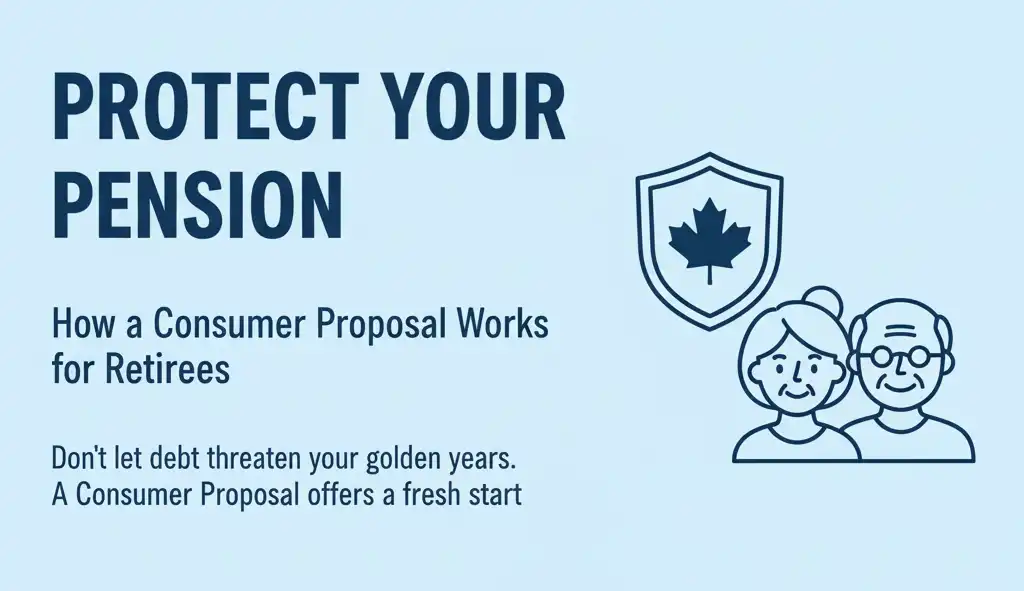Table of Contents

Retirement, Debt, and Your Pension: An Overview
Retirement in Ontario should be a time of peace, not financial stress. However, for many seniors on a fixed income, looming unsecured debt can create constant anxiety. A common, urgent question we hear is: “Can my cr editors take my pension?” The short answer is: No, your core government pensions like CPP and OAS are protected by federal law from most creditors. Furthermore, a consumer proposal, a formal, legal process governed by Canada’s Bankruptcy and Insolvency Act, provides a powerful way to eliminate debt while ensuring your retirement income remains yours. Key Takeaway: A consumer proposal legally stops most collection actions and garnishments, consolidates your unsecured debts into one affordable, interest-free monthly payment, and allows you to keep receiving your CPP, OAS, and other protected pension income as normal.Understanding Your Retirement Income vs. Your Debts
In retirement, your income is typically a blend of different sources, each with different rules:- Government Pensions: Canada Pension Plan (CPP) and Old Age Security (OAS).
- Employer Pensions: Defined Benefit (DB) or Defined Contribution (DC) plans from your past employment.
- Personal Savings: Registered Retirement Savings Plans (RRSPs) and Registered Retirement Income Funds (RRIFs).
Can Creditors Garnish Your Pension in Ontario?
This is the most critical question for retirees facing debt. Here is the breakdown based on the type of income.CPP and OAS
By law, under the Canada Pension Plan Act and the Old Age Security Act, these benefits cannot be assigned, charged, or given as security to a private creditor. A credit card company cannot garnish your CPP or OAS at the source.- The Major Exception (CRA): The Canada Revenue Agency (CRA) is not a normal creditor. It has unique legal powers to garnish government benefits, including CPP and OAS, to pay off outstanding tax debt or other government debts.
- After Deposit: Once the money is in your bank account, it can be vulnerable. If you owe money to the same bank where your pension is deposited (e.g., a credit card), the bank may claim a “right of set-off” and take funds from your account.
Employer Pensions (e.g., in Ontario)
Private and employer pensions are typically governed by provincial laws. In Ontario, the Pension Benefits Act provides strong protections, generally shielding locked-in pension funds from seizure by creditors.RRSPs and RRIFs
In an insolvency, RRSPs and RRIFs are legally exempt from seizure, meaning they are safe. There is one important exception: any RRSP contributions made in the 12 months *before* filing your proposal can be “clawed back” by the trustee. Your Licensed Insolvency Trustee will review this with you.
Why a Consumer Proposal is an Effective Tool for Retirees
A consumer proposal is often the ideal solution for seniors on a fixed income for several key reasons:- Immediate Protection: The moment you file, a stay of proceedings is initiated, which legally stops most collection calls, lawsuits, and garnishments.
- Income Stability: You continue to receive 100% of your CPP, OAS, and other pensions. Your proposal payment is calculated based on what you can afford, not what creditors demand.
- Keep Your Assets: Unlike bankruptcy, a consumer proposal allows you to keep all your assets, including your home, car, and protected retirement savings.
- Predictable Payments: Your payment is fixed and interest-free for a set period (up to 5 years). This is crucial for managing a fixed retirement budget.
- Resolves Tax Debt: It is one of the most powerful tools to stop CRA collections and formally resolve your outstanding tax liabilities.
How the Consumer Proposal Process Works
Working with a Licensed Insolvency Trustee is a clear, confidential, and respectful process:- Book a Free Consultation: You will meet with a Trustee for a free, no-obligation consultation. They will review your income (CPP, OAS, etc.), debts, and budget.
- Gather Your Information: You will provide details on your finances, such as income statements, debt balances, and essential living expenses.
- Draft a Fair Offer: Your Trustee helps you craft a single, affordable monthly payment offer to your creditors.
- File for Legal Protection: Once filed, the stay of proceedings begins immediately, and collection calls stop.
- Creditor Vote: Your creditors have 45 days to vote. If the majority (by dollar value) accept, the proposal is legally binding on all unsecured creditors.
- Make Your Payments: You make your single monthly payment to the Trustee, who distributes it to your creditors.
- Complete Counselling: You will attend two brief financial counselling sessions to help with budgeting and financial planning.
- Debt Freedom: After your final payment, you receive a Certificate of Full Performance, and your included debts are legally erased.
Real-World Scenarios for Retirees
Scenario 1: The CRA Tax Debt
Situation: Mary, an Ontario retiree, has $30,000 in old tax debt. The CRA sends a letter stating they will start garnishing her CPP and OAS. How a Proposal Helps: Mary’s LIT files a consumer proposal offering $300/month for 5 years ($18,000 total). The CRA garnishment stops immediately. Once accepted, her tax debt is legally settled by the proposal, and she keeps her full pension.Scenario 2: The Bank Set-Off
Situation: John receives his CPP deposit into his chequing account at the same bank where he has a $15,000 credit card. The bank is threatening to take his pension money from his account. How a Proposal Helps: John’s LIT advises him to open an account at a neutral bank (where he owes no money). He then files a proposal. The stay of proceedings stops the bank’s right of set-off, and his new account is protected.Scenario 3: Overwhelming Credit Card Debt
Situation: A retired couple has $50,000 in credit card debt. The minimum payments are so high they are forced to use their credit cards for groceries, and the debt keeps growing. How a Proposal Helps: They file a joint proposal to pay $450/month for 5 years ($27,000 total). The interest is frozen, their $50,000 of debt is consolidated, and they are on a clear path to being debt-free while living on their fixed income.Consumer Proposal vs. Bankruptcy for Retirees
While both options provide debt relief, retirees often prefer a consumer proposal.| Feature | Consumer Proposal | Bankruptcy |
|---|---|---|
| Debt forgiveness | Partial repayment of a reduced balance | Full discharge after required period |
| Pension protection | CPP, OAS, and employer pensions continue | Protected, but surplus income rules may apply |
| RRSP treatment | Protected, except last 12 months’ contributions | Same 12-month contribution rule |
| Credit rating | R7 (less severe) | R9 (most severe) |
| Assets | Typically retained (e.g., house, car) | Some non-exempt assets may be surrendered |
| Duration | 1–5 years; can pay early | ~9–21 months (first-time) |
When to Talk to a Licensed Insolvency Trustee
It’s time to seek professional help if you are experiencing any of the following:- You are using credit cards to pay for essential expenses like groceries, medication, or utilities.
- You are receiving stressful collection calls or letters.
- You have received a notice of garnishment for your pension or bank account.
- You are afraid to answer the phone or open your mail.
- You are worried about CRA debt and its impact on your CPP or OAS.
- You are considering withdrawing from your RRSP to pay unsecured debts (this is often a bad idea).
Frequently Asked Questions
Will filing a consumer proposal affect my CPP or OAS income?
No. You will continue to receive these benefits as usual. They are protected by federal law and are not part of the assets reviewed in your proposal.Can a consumer proposal stop CRA from taking my pension for tax debt?
Yes, in most cases. Once the proposal is filed and accepted, CRA collection actions on included debts, including garnishments, must stop.I am retired and my income is only CPP and OAS. Can I still file?
Yes. Your trustee will tailor payments to your budget. Some retirees choose a small monthly amount; others may use a one-time lump sum from family or a small (non-RRSP) saving account.What happens to my spouse’s pension or income if I file?
Your spouse’s income and pensions are not affected unless they are a co-signer or joint borrower on your debts. Your LIT can advise on the best strategy, whether filing alone or jointly.How long will a consumer proposal stay on my credit report?
A consumer proposal is reported as R7 on your credit report for three years after completion, or six years from filing, whichever comes first. See Equifax guidance and the FCAC.Will I lose my RRSPs or RRIFs?
No. These accounts are generally exempt, except for RRSP contributions made within the 12 months before filing.Get Help Today and Protect Your Retirement
At Doyle Salewski, our Licensed Insolvency Trustees help Canadians in Ontario and Quebec find dignified solutions to debt. We are specialists in debt help for seniors and understand how to protect your pension income. Whether you face tax debt, credit cards, or collection calls, we will help you choose the right path—without risking your CPP, OAS, or retirement savings. Book your free, confidential consultation to start your path toward financial peace of mind. Related Resources:Sources
Last verified October 24, 2025- Office of the Superintendent of Bankruptcy — Consumer proposals
- OSB — Creditors contacting you after you file
- Bankruptcy and Insolvency Act s.66.22 — Deemed court approval
- Canada Pension Plan Act s.65 — Non-assignability
- Old Age Security Act s.36 — Non-assignability
- Canada Revenue Agency — Garnishing your income or assets
- Equifax — How long information stays on your credit report
- Financial Consumer Agency of Canada — Information on your credit report
Disclaimer: This article provides general information about consumer proposals in Ontario and is not legal, accounting, or financial advice. For personal guidance, speak with a Licensed Insolvency Trustee.





